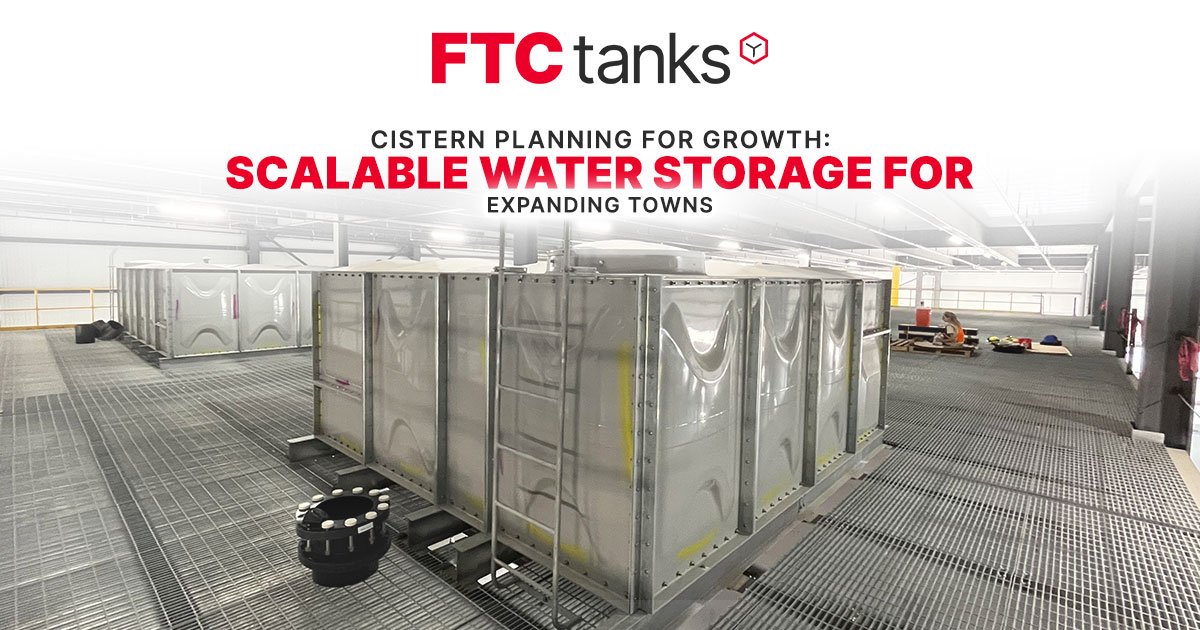Small towns grow faster than many expect. New housing, businesses, and tourism add pressure to every utility. Water systems are often among the first to struggle. A reliable cistern setup makes the difference between smooth growth and constant shortages.
Many towns delay upgrading water storage until the system is already under strain. This leads to expensive, rushed fixes and public frustration. The smarter move is to plan now for tomorrow’s needs. Water tanks that are built for expansion give a community more control over its future.
Why ‘Scalable’ Should Be the New Standard
Sizing water storage tanks for today’s population might seem sensible. In reality, it locks a community into costly upgrades down the road. A scalable system supports a town’s growth for decades without major overhauls. FRP water tank designs allow for this flexibility.
The goal is not only meeting current demand. It’s anticipating higher usage, seasonal changes, and emergencies.
Beyond the Here-and-Now
Seasonal tourism can double or triple water demand in weeks. Industrial projects can strain supply overnight. In emergencies, firefighting can drain a water cistern in minutes. An undersized system leaves residents and businesses vulnerable.
Meeting NFPA Water Tank guidelines ensures a town can handle fire emergencies. Storing extra capacity helps in droughts and heatwaves.
Planning Like an Engineer, Thinking Like a Mayor
To create a truly scalable plan:
- Forecast realistic population growth.
- Include tourism and seasonal spikes.
- Factor in industrial and commercial needs.
- Match storage with NFPA Water Tank standards.
- Allow room for modular expansion.
Choosing the Right Tank — And Material Matters
The material you choose for water storage tanks shapes the system’s reliability for decades. FRP tanks are leading the way for towns that value durability, safety, and flexibility.
Why FRP Tanks Are a Practical Choice
FRP tanks resist corrosion from moisture, chemicals, and soil contact. They are lighter than concrete or steel, making installation faster and easier. They work well in areas with freeze-thaw cycles and don’t crack like some plastics. This reliability means fewer repairs and longer service life.
Compared to steel, FRP water tank designs need less maintenance and don’t rust. Compared to concrete, they are easier to relocate or expand. Over 40 years, the savings in repairs and replacements are significant.
NSF and NFPA — Not Just Alphabet Soup
NSF certified water tanks guarantee that stored water remains safe for human use. These tanks meet strict hygiene standards, giving residents confidence in their drinking supply.
NFPA Water Tank standards ensure enough reserve water is available for firefighting. These rules are not just bureaucracy—they save lives and property. Meeting both NSF and NFPA requirements builds trust with regulators and the public.
The Multi-Role Cistern — One Tank, Many Jobs
A modern cistern can do more than store drinking water. It can also supply irrigation systems and serve as a fire tank reserve. This multi-use approach reduces costs and simplifies maintenance. FRP tanks handle these roles without contaminating potable water.
Example Capacities and Uses
| Tank Capacity (Gallons) | Ideal Use Case | Notes |
|---|---|---|
| 50,000 | Small community drinking supply | NSF-certified water tanks recommended |
| 100,000 | Mixed residential + small fire reserve | Meets NFPA Water Tank basic standards |
| 250,000 | Large town + commercial fire suppression | Consider modular FRP water tank setups |
| 500,000+ | Expanding city, industrial & firefighting | Needs zoning & advanced pump infrastructure |
Modular Thinking — Build Now, Expand Later
Scalable planning is not just about big tanks. It’s about smart tanks that can grow with the town. This is where FRP tanks excel.
How FRP Tanks Make Growth Easy
- Modular sections added with minimal downtime.
- Expansion without replacing the entire water cistern.
- Lower lifetime cost compared to new builds.
- Smaller land footprint than multiple small water tanks.
Because FRP water tank designs are modular, towns can add storage in phases. This avoids paying for unused capacity in the early years.
Future-Proofing Without Overspending
Budgets for water storage projects are often tight. Phased expansion with FRP tanks allows towns to invest only when demand grows. Early partnerships with engineers and tank suppliers make scaling smoother.
Your Next Steps Toward Scalable Water Security
Every town’s path to reliable water storage starts with good data.
Start with a Water Audit
A water audit measures current daily use, peak seasonal demand, and emergency needs. It also identifies weaknesses in your water cistern and distribution system.
Engage Certified Suppliers
Work with providers who deliver NSF certified water tanks. Check their track record with FRP tanks and NFPA Water Tank compliance. A trustworthy supplier ensures quality installation and long-term performance.
Final Drop of Wisdom
Water storage tanks aren’t just big containers — they’re a town’s safety net. They keep taps running, sprinklers spraying, and fire hoses ready when it matters most. Communities that choose scalable FRP water tank systems now are setting themselves up to avoid the headaches and heavy costs of last-minute fixes later.
Getting it right from the start means thinking about more than today’s needs. The right cistern, built with the right material and sized with room to grow, will serve the community for decades. It’s not just a tank — it’s peace of mind for every home, school, and business in town.
If your town is growing, don’t wait until storage runs short. Talk to the specialists at FTC Tanks who know the ins and outs of water storage, from design and NSF certified water tanks to NFPA Water Tank compliance. They’ll help you plan a system that’s safe, reliable, and ready to grow with your community.
Plan ahead. Protect your water. Choose FTC Tanks for the long haul.





